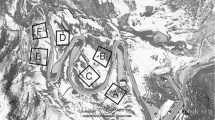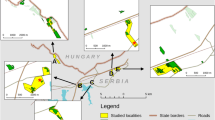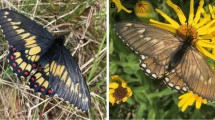Summary
The numbers, dispersal behavior, aging and residence, and Wrightian neighborhood configurations of three species of Colias butterflies have been studied in central Colorado, using mark-release-recapture techniques as major tools. All populations studied have nonoverlapping generations and mature one brood each year. A brief general review of these species' autecology is given. A system for measuring degree of physical damage to the adults is introduced. This “wear rating” varies with temporal position of any given sample in the course of a brood's flight season, the insects becoming progressively more damaged with time. The sex ratio also changes with brood aging: males eclose before females, and are in the majority early in the flight season, while females may predominate at the end of flight. Local population numbers for the montane grassland species C. alexandra may reach peak levels of 700–900 insects in favorable years, but be much lower in other years as a result of, e.g., drought. Peak densities are no more than 2/ha. The montane bog species, C. scudderi, maintains comparable low density but has much smaller local populations. The subalpine/alpine grassland species C. meadii displays peak local numbers as high as 3000, with peak density as high as 120/hectare. Dispersal varies both among and within species. Those C. alexandra who disperse show an average dispersal radius of about 1.3 km, with a radius for the whole population of about 0.6 km; maximum distance moved was 8 km. Dispersal proportions among recaptures are sharply curtailed by adverse weather, but the dispersal radius of those moving is unaffected by weather. C. scudderi's dispersal is strongly influenced by the geometry of its bog and streamside habitats. Some C. meadii populations approach isolated “island” status, but others show much dispersal. Dispersal radius of those dispersing ranges from 0.3 to 0.7 km in different populations, but the proportion of dispersals varies greatly. The longest observed movement by this species is 1.3 km, although up to 2.6 km could have been detected. Colias normally display constant loss (death plus emigration) rates with average residence expectations of 4–6 days; few insects reach their maximum physiological lifespan of approximately 1 month. Bad weather can increase the loss rate drastically. Females show shorter residence than males, appearently as a result of greater mortality. Total-numbers-per-brood estimates are given for our better studied populations. The reproductive strategy of Colias is such that Wright's models for neighborhood size apply. Neighborhood size for C. alexandra varied sixfold in numbers, and from 3 to 1.3 km in physical extent, between a favorable year and a drought year. One localized C. scudderi habitat is only 200 m in diameter, but a streamside population has a neighborhood length of 4.8 km. In C. meadii, one population of 2000–2500 insects is an 8-ha “island”, while another of similar numbers extends a single neighborhood across 1.9 km distance, 450 m altitude, and a major ecological boundary (timberline). Factors such as weather, individuals' visual cueing, and thermoregulatory behavior can influence population structure. For some Colias populations, selection may be very uniform within neighborhoods, while for others, single neighborhoods cross sharp discontinuities in selective forces. These patterns may differ for different selective forces, and may also vary with stages of the insects' life cycle. these populations will now prove a valuable resource for studying evolutionary population genetics.
Similar content being viewed by others
References
Ae, S.A.: Comparative studies of developmental rates, hibernation, and food plants in North American Colias (Lepidoptera, Pieridae). Amer. Midl. Nat. 60, 84–96 (1958)
Brown, F.M., Eff, D., Rotger, B.: Colorado butterflies, 368 pp. Denver: Denver Museum of Natural History 1957
Brussard, P.F., Ehrlich, P.R.: The population structure of Erebia epipsodea (Lepidoptera: Satyrinae). Ecology 51, 119–129 (1970)
Burns, J.M., Johnson, F.M.: Esterase polymorphisms in natural populations of a sulfur butterfly, Colias eurytheme. Science 156, 93–96 (1967)
Chew, F.S.: Strategies of foodplant exploitation in a complex of oligophagous butterflies (Lepidoptera). Ph.D. thesis, 232 pp., Yale University, New Haven (1974)
Chew, F.S.: Coevolution of pierid butterflies and their cruciferous foodplants. I. The relative quality of available resources. Oecologia (Berl.) 20, 117–127 (1975)
Cook, L.M., Brower, L.P., Croze, H.J.: The accuracy of a population estimation from multiple recapture data. J. anim. Ecol. 36, 57–60 (1967)
Deevey, E.S.: Life tables for natural populations of animals. Quart. Rev. Biol. 22, 283–374 (1947)
Ehrlich, P.R.: Intrinsic barriers to dispersal in a checkerspot butterfly. Science 134, 108–109 (1961)
Ehrlich, P.R.: The population biology of the butterfly Euphydryas editha. II. The structure of the Jasper Ridge colony. Evolution 19, 327–336 (1965)
Ehrlich, P.R., Davidson, S.E.: Techniques for capture-recapture studies of Lepidoptera populations. J. Lepid. Soc. 14, 227–299 (1960)
Ehrlich, P.R., Gilbert, L.E.: Population structure and dynamics of the tropical butterfly Heliconius ethilla. Biotropica 5, 69–82 (1973)
Ehrlich, P.R., White, R.R., Singer, M.C., McKechnie, S.W., Gilbert, L.E.: Checkersport butterflies: a historical perspective. Science 188, 221–228 (1975)
Johnson, G.B.: Enzyme polymorphism and adaptation. Stadler Symp. Genet. 7, 91–116 (1975)
Jolly, G.M.: Explicit estimates from capture-recapture data with both death and immigration-stochastic model. Biometrika 52, 225–247 (1965)
Langenheim, J.: Vegetation and environmental patterns in the Crested Butte Area, Gunnison Conty, Colorado. Ecol. Mon. 32, 249–285 (1962)
Levins, R.: Evolution in changing environments, 120 pp. Princeton, N.J.: Princeton Univ. Press 1968
MacArthur, R., Levins, R.: Competition, habitat selection, and character displacement in a patchy environment. Proc. nat. Acad. Sci. (Wash.) 51, 1207–1210 (1964)
Remington, C.L.: The genetics of Colias (Lepidoptera). Advanc. Genet. 6, 403–450 (1954)
Roff, D.A.: On the accuracy of some mark-recapture estimators. Oecologia (Berl.) 12, 15–34 (1973a)
Roff, D.A.: An examination of some statistical tests used in the analysis of mark-recapture data. Oecologia (Berl.) 12, 35–54 (1973b)
Rohlf, F.J., Sokal, R.R.: Statistical Tables, 253 pp. San Francisco: Freeman 1969
Scott, J.A.: Convergence of population biology and adult behavior in two sympatric butterflies, Neominois ridingsii (Papilionoidea: Nymphalidae) and Amblyscirtes simius (Hesperioidea: Hesperiidae). J. anim. Ecol. 42, 663–672 (1973)
Sherman, P.W., Watt, W.B.: The thermal ecology of some Colias butterfly larvae. J. comp. Physiol. 83, 25–40 (1973)
Sokal, R.R., Rohlf, F.J.: Biometry, 776 pp. San Francisco: Freeman 1969
U.S. Geological Survey: Bristol head, Colo. Quadrangle Map. 15' series, Denver (1959)
U.S. Geological Survey: Cannibal Plateau, Colo. Quadrangle Map. 7 1/2' series, Denver (1963)
U.S. Geological Survey: Garfield, Colo. Quadrangle Map. 15' series, Denver (1940)
U.S. Geological Survey: Gothic, Colo. Quadrangle Map. 7 1/2' series, Denver (1961)
U.S. Geological Survey: Oh-be-joyful, Colo. Quadrangle Map. 7 1/2' series, Denver (1961)
Veldman, D.J.: Fortran programming for the behavioral sciences, 406 pp. New York, N.Y.: Holt, Rinehart, Winston 1967
Watt, W.B.: Adaptive significance of pigment polymorphisms in Colias butterflies. I. Variation of melanin pigment in relation to thermoregulation. Evolution 22, 437–458 (1968)
Watt, W.B.: Adaptive significance of pigment polymorphisms in Colias butterflies. III. Progress in the study of the “alba” variant. Evolution 27, 537–548 (1973)
Watt, W.B., Hoch, P.C., Mills, S.G.: Nectar resource use by Colias butterflies: chemical and visual aspects. Oecologia (Berl.) 14, 353–374 (1974)
Wright, S.: Isolation by distance under diverse systems of mating. Genetics 31, 39–59 (1946)
Wright, S.: The genetical structure of populations. Ann. Eugenics 15, 323–354 (1951)
Author information
Authors and Affiliations
Rights and permissions
About this article
Cite this article
Watt, W.B., Chew, F.S., Snyder, L.R.G. et al. Population structure of pierid butterflies. Oecologia 27, 1–22 (1977). https://doi.org/10.1007/BF00345682
Received:
Issue Date:
DOI: https://doi.org/10.1007/BF00345682




